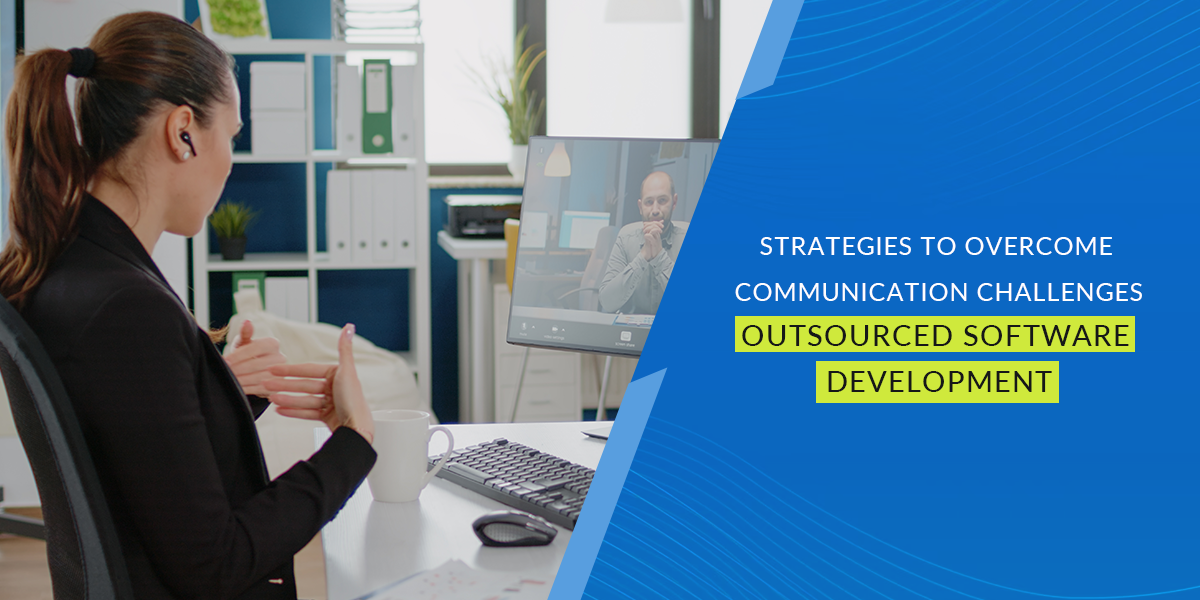Choosing the right software development methodology can be confusing. There are so many choices, and figuring out which one fits your needs is hard.
Opting for the wrong methodology can slow things down, cause problems, and be a big headache for your project.
While Agile software development methodology is widely known, let’s set it aside for now and delve into a comprehensive exploration of various software development methodologies.
Don’t worry! This guide breaks it down in simple terms. You’ll learn how to choose the perfect software development methodology so your project runs smoothly. But let’s start with the basics.
What Is Software Development Methodology?
When it comes to software development, having a well-defined methodology for the Software Development Lifecycle (SDLC) is essential for success. A software development methodology is a framework or process that guides the development team in building software applications efficiently and effectively. It provides a structured approach to managing the project, ensuring that the software meets the requirements and is delivered on time. By following a specific methodology within the SDLC, development teams can streamline their workflow, enhance collaboration, and produce high-quality software, aligning with the overarching goal of successful software delivery.
Advantages of Using a Software Development Methodology
There are several advantages to using a software development methodology.
- Software development methodology provides a clear roadmap for the development process. This allows the team to have a better understanding of the project scope, timeline, and deliverables. It also helps in managing the expectations of stakeholders and clients.
- It encourages collaboration and communication among team members. By following a set of predefined processes, team members can work together seamlessly, leading to improved productivity and efficiency.
- Software development methodology ensures that the software is developed iteratively, with regular feedback and testing. This iterative approach allows for flexibility and adaptability, ensuring that the final product meets the needs of the end-users.
Current Statistics on the Different Software Development Methodologies Used:
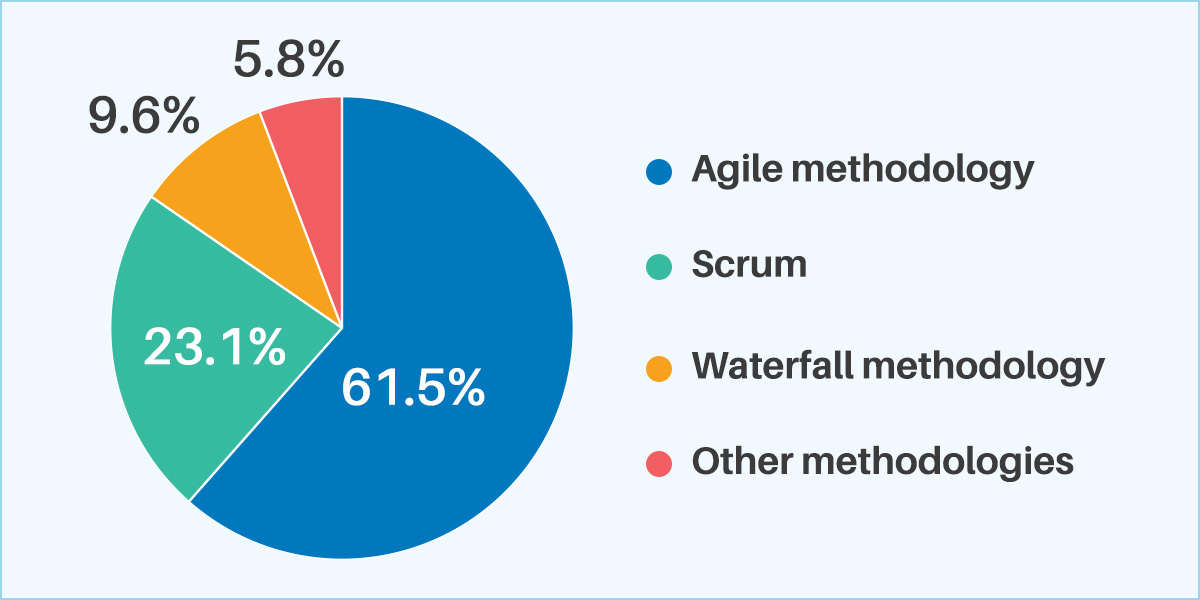
Current statistics on software development methodologies highlight diverse preferences across industries.
Agile methodology is the most prevalent as per the research, capturing 61.5% of software development practices due to its adaptability and iterative nature, which aligns well with dynamic project requirements.
Scrum follows at 23.1%, a subset of Agile, valued for its structured sprints and emphasis on regular team evaluation, leading to continuous improvement and effective project management.
Waterfall methodology persists with a 9.6% usage rate, favored in scenarios with clear, unchanging requirements due to its sequential and straightforward approach, providing predictability and well-defined project phases.
Other methodologies account for 5.8%, including hybrid or specialized approaches tailored to unique project needs, indicative of the field’s innovative and adaptive character.
The trend reflects a shift towards flexible, collaborative methodologies like Agile and Scrum but also highlights the ongoing relevance of traditional methods like Waterfall in certain project contexts.
5 Leading Software Development Methodologies
- Agile
- Waterfall
- Scrum
- Lean
- Rapid Application Development
Above are the leading software development methodologies for making software. Let’s look at what each one does best and its downsides, to figure out which is right for different kinds of projects.
Agile Software development
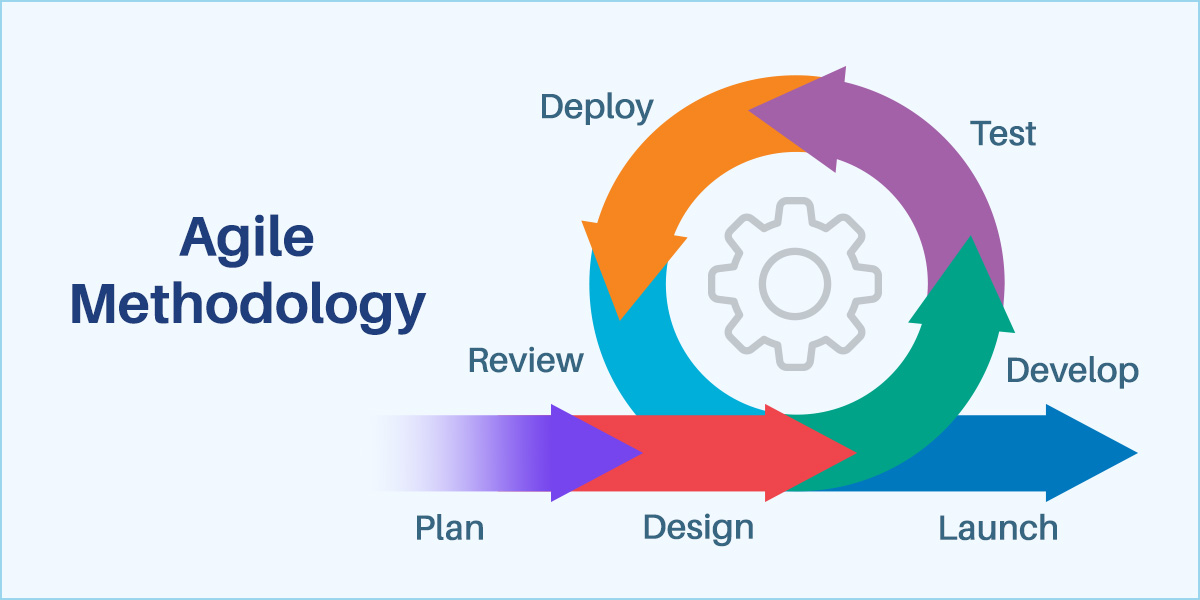
Agile software development methodology is a dynamic and iterative approach to software development that emphasizes flexibility, team collaboration, and customer satisfaction. This software development methodology is designed to accommodate changes and deliver functional software quickly through short, manageable phases known as sprints. Each sprint aims to produce a minimum viable product or a workable feature, allowing teams to continuously improve and adapt their product based on feedback from stakeholders.
Agile software development methodology encourages daily meetings and close cooperation among team members and with clients, fostering a culture of transparency, accountability, and shared responsibility.
One of the core strengths of Agile software development methodology is its focus on customer involvement and satisfaction. By engaging clients and stakeholders throughout the development process, Agile ensures that the end product is closely aligned with the customer’s needs and expectations. This constant interaction helps in identifying and addressing changes swiftly, reducing the risk of project failure.
The benefits of agile software development are manifold, including enhanced product quality, increased project transparency, and accelerated time to market, all of which contribute to superior customer satisfaction and competitive advantage.
The emphasis on teamwork, continuous feedback, and adaptability underpins Agile’s success, making it a preferred choice for organizations striving for excellence in an ever-changing market.
Advantages:
- Agile allows teams to adapt to changes quickly. If the project needs to shift direction, it’s easy to make those changes.
- By involving the customer throughout the development process, Agile ensures the final product meets their needs and expectations.
- With its focus on delivering small, functional parts of the project regularly, Agile allows for quicker releases to the market.
- Regular reviews and feedback loops mean the product, processes, and team can improve throughout the project.
Disadvantages:
- Agile’s flexibility can make it harder to predict the final cost and delivery date of the project.
- Without careful management, the scope of the project can grow indefinitely due to its iterative nature and the constant addition of features.
- Agile relies heavily on the team’s ability to self-organize, which can be challenging for teams lacking experience.
- With the focus on quick delivery of features, documentation might not be as thorough compared to more traditional methodologies.
Waterfall software development
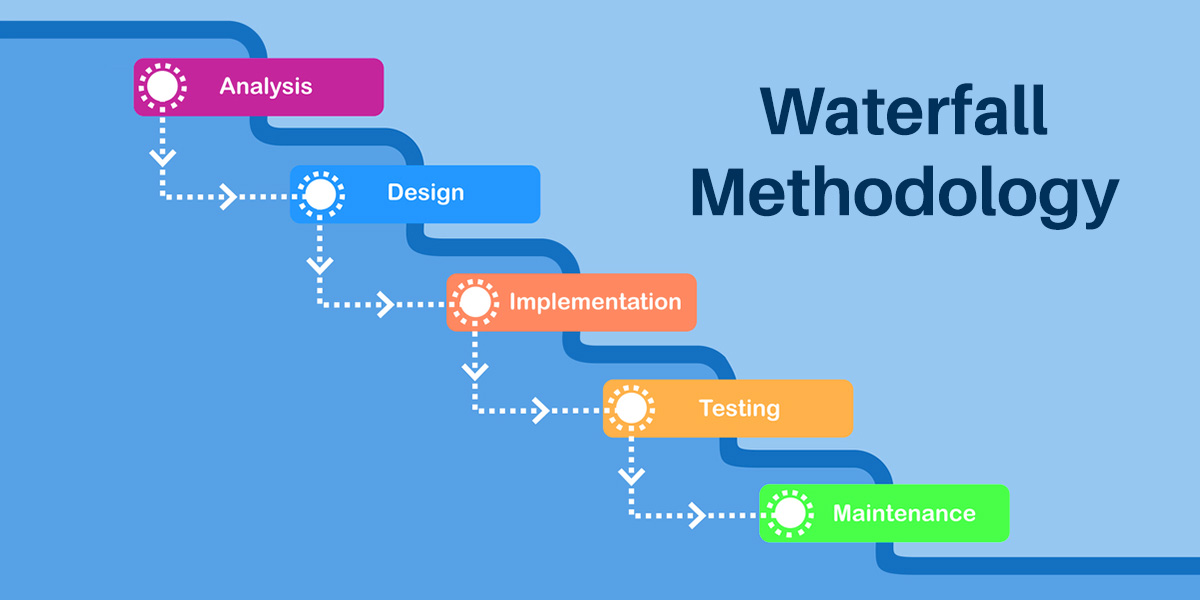
The Waterfall software development methodology is a traditional project management approach characterized by a linear and sequential progression, where each phase of the project lifecycle must be completed before the next one can begin. This software development methodology divides the project into distinct stages, including requirements analysis, system design, implementation, testing, deployment, and maintenance.
One of the key features of the waterfall software development model is its structured and straightforward approach, which allows for meticulous planning and execution. It is particularly effective for projects with well-defined requirements and a clear understanding of the scope from the outset. The predictability of the process makes it easier to estimate timelines and budgets, making it a preferred choice for projects where changes are unlikely or can be minimized.
Advantages:
- The waterfall model is straightforward. You finish one thing, then move on to the next, making it easy for everyone to follow.
- Since every step has to be completed and reviewed before moving on, it ensures that everything is done thoroughly and nothing is missed.
- It’s easier to figure out how much time and money the project will need because everything is laid out from the start.
- Since you plan everything upfront, you can catch potential issues before they become big problems.
Disadvantages:
- If you need to make changes, it can be really tough because you’ll have to go back and redo a lot of work.
- If you’re not 100% sure what you need at the start or if things might change, the waterfall model can be a bad fit. It doesn’t handle surprises well.
- Since the final product is only revealed at the end, there’s a risk that it won’t meet the users’ needs or expectations if those needs have changed during the project.
Scrum Software Development
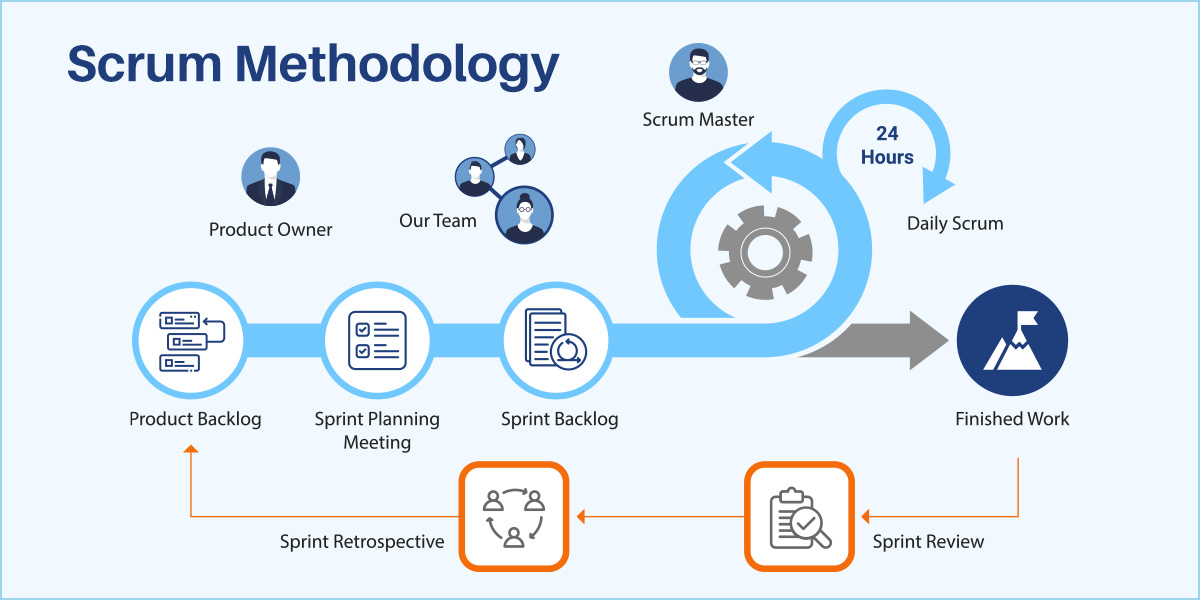
Scrum software development methodology is used by teams to manage software projects through regular meetings and fixed-length work phases called sprints. It helps teams work together to quickly adjust to changes and complete parts of the project in steps.
Everyone has a clear role: The product owner decides what needs to be done, the Scrum Master helps everyone follow the rules, and the development team does the actual work.
This approach makes sure the work is done efficiently and allows the team to easily respond to changes. It’s all about teamwork, regular updates, and keeping the project moving forward. Scrum software development methodology makes it easier to deliver what’s needed and adjust as things change, making it a popular choice for managing software projects.
Scrum software development is designed for teams of three to nine members who can complete the project in two weeks.
Advantages:
- Scrum lets teams change their plans quickly based on new ideas or feedback, making it great for projects that evolve over time.
- With regular short work periods and meetings, teams can keep track of what they need to do more efficiently, getting things done faster.
- Teams regularly talk about what’s working and what isn’t, so they can do better in the next round of work.
- Scrum encourages everyone to work closely and talk openly, so everyone knows what’s going on and can help out.
Disadvantages:
- Scrum requires everyone to be really disciplined and stick to the plan, which can be hard for some teams.
- How well Scrum works can really depend on whether the team works well together and whether the leaders (Scrum Master and Product Owner) are good at their jobs.
- Not suitable for large projects
Lean Software development
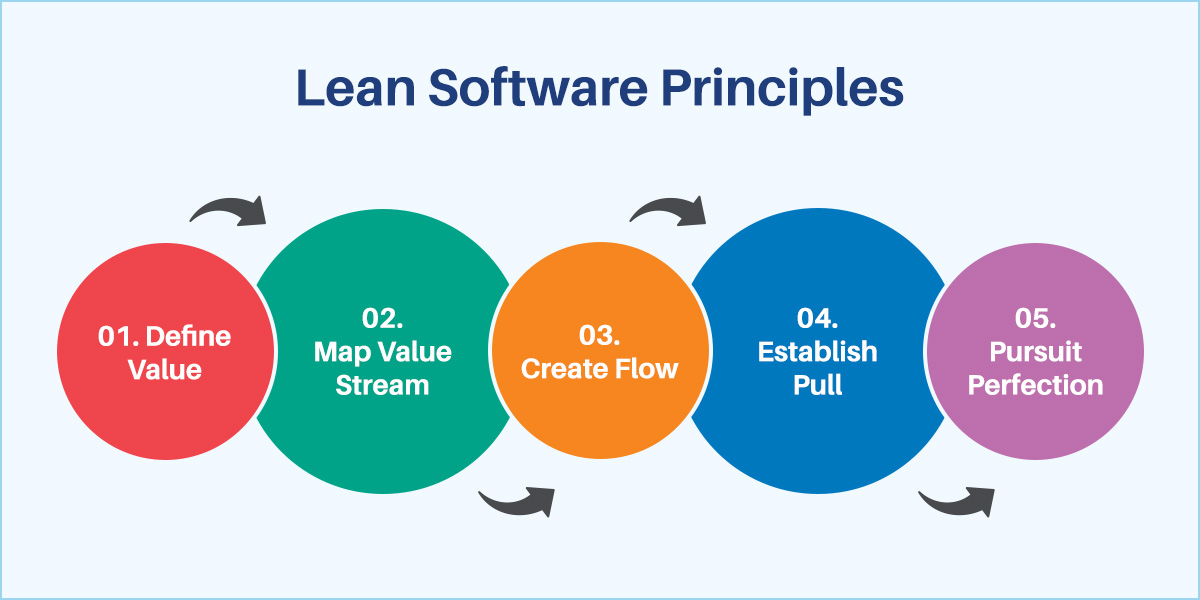
Lean Software Development methodology is all about making software creation smarter and faster by getting rid of anything that doesn’t help get the job done. Think of it like cleaning up your workspace: when everything’s tidy, you can find what you need and work more efficiently.
This software development method borrows ideas from how Toyota streamlined its car manufacturing to waste less and deliver more value to customers. The main goal is to focus on what the users really need and make sure they get it without unnecessary delay or extra bells and whistles they won’t use.
In practice, this means the team keeps checking and adjusting their work based on feedback, making sure they’re always on the right track and can change direction quickly if needed.
By focusing on what’s truly important and avoiding waste, teams can create better software that users love, and they can do it faster and more efficiently.
Advantages:
- It helps teams work smarter, not harder, making it possible to create software quickly by focusing only on what’s really necessary.
- This approach allows teams to easily change their plans based on new information or feedback, ensuring they’re always working on what matters most.
- By prioritizing the needs of the users, the final product is more likely to hit the mark, satisfying users because it’s built around their actual needs.
- Teams have more control and say in their work, leading to better morale and potentially more innovative solutions.
Disadvantages:
- Applying Lean methods can get tricky as teams and projects get larger, potentially diluting its benefits.
- While user input is vital, it can sometimes be hard to get or may not always point in a clear direction, which can stall progress.
- In the rush to move fast and cut out waste, teams might not document their work thoroughly, making it harder to understand or update the software later on.
Rapid Application Development
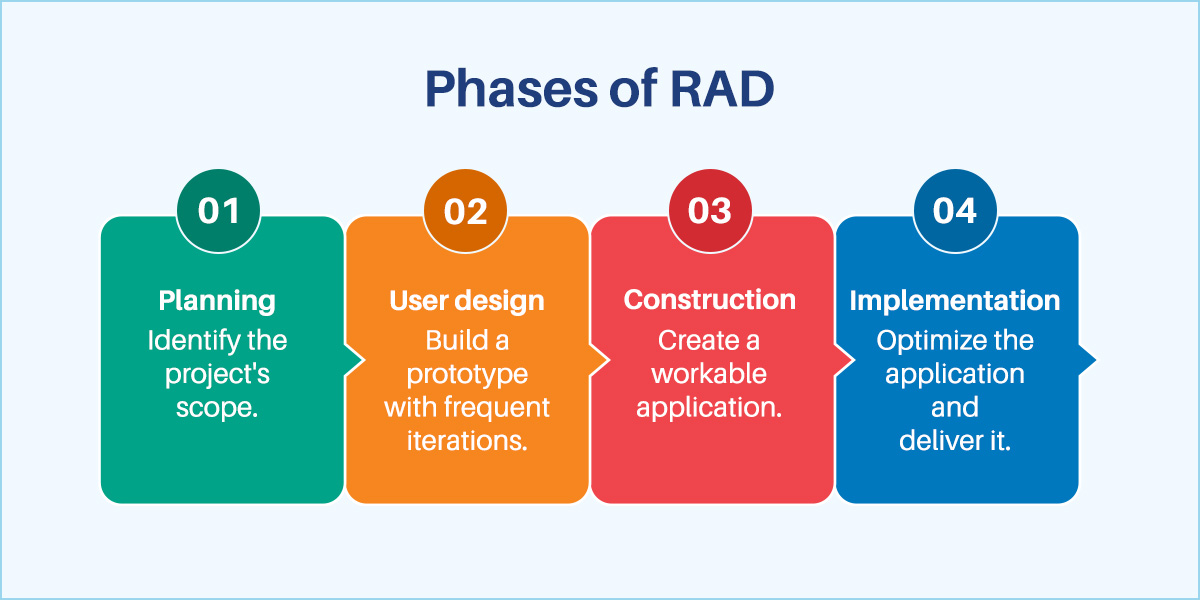
Rapid Application Development (RAD) is a quick method in software development that focuses on going step by step and getting feedback from users right away. Instead of taking a long time planning and then building the software step by step, RAD focuses on making a basic version fast and then improving it based on what people need. It’s like sketching a rough drawing and then filling in the details as you go. This method is great because it lets developers make changes easily and helps make sure the final software really helps its users.
In the RAD approach within software development, the team works directly with the users, gathering their feedback early in the process. This allows for immediate adjustments, making the software more effective for its intended users. The steps in this method include planning, designing, building, and then fine-tuning to address any last-minute needs. This strategy speeds up the creation of high-quality software, meeting the rapid pace of today’s software development requirements.
Advantages:
- RAD helps finish projects faster, so you can see your software working sooner.
- It’s easy to make adjustments as you go, making sure the software really fits what’s needed.
- Since users help shape the project, they’re more likely to be pleased with the end product.
- Catching problems early means fewer big surprises later, making the whole process smoother.
- Focusing on the most important parts and getting feedback early can save resources.
Disadvantages:
- For really large projects, RAD can be tough to manage because of all the changes and the need for lots of user feedback.
- The rush to get things done might mean not everything is written down or thought through, which could cause issues later.
- Moving fast might mean not checking everything as thoroughly as should be, so there’s a chance the quality could suffer.
Choosing the Right Software Development Methodology
When engaging in the comparison of software development methodologies, employing a detailed checklist is vital for evaluating how each methodology aligns with specific aspects of your project and organizational needs. This approach ensures a thorough analysis and aids in making an informed decision. Consider the following factors in your checklist:
| Criteria | Agile | Waterfall | Lean | Scrum | RAD |
|---|---|---|---|---|---|
| Scope and Size | Flexible for various sizes | Best for large, complex projects | Ideal for any size | Fast delivery | Small projects, quick turnaround |
| Complexity | Handles changing well | Clear, unchanging requirements | Simplifies, focuses on value | Manages complex projects | Less complex, speed-needed |
| Team Size and Distribution | Adaptable, collaborative | Larger, distributed teams | Efficient communication | Small to medium, co-located | Small, cohesive teams |
| Stakeholder Involvement | High, iterative feedback | Limited after requirements | Continuous, value delivery | High, involves stakeholders | High, needs user involvement |
| Deadline Constraints | Flexible, iterative | Fixed, detailed planning | Speed, efficiency | Predictable schedules | Rapid development for tight deadlines |
| Flexibility and Adaptability | High, easily pivot | Low, changes difficult | Quickly adapt, remove inefficiencies | High, allows adjustments | High, rapid prototyping |
| Risk Tolerance | Moderate to high | Low, identified early | High, learning and adjusting | Moderate to high | Moderate, early feedback reduces risks |
| Quality Assurance Processes | Integrated testing | Testing at end | Built-in quality | Continuous testing | Early testing, less comprehensive |
| Resource Availability | Skilled, adaptable team | Planned, allocated upfront | Efficient use of resources | Dedicated team members | Resources for rapid prototyping |
| Budget Constraints | Cost-effective, varies | Fixed, changes increase costs | Minimizes waste, reduces costs | Predictable costs | Cost-effective, scope-dependent |
Our Approach to Client Methodologies
When it comes to us at Zaigo Infotech, a software development company with over 9+ years in the industry, we’ve learned how to deliver the best results for our clients. Known across India for crafting top-notch software products, we’ve successfully completed over 800 projects in more than 15 different sectors. Our secret? We love using the Agile method, which means we work closely with our clients, change plans easily when needed, and make sure everything is clear to everyone involved.
At Zaigo Infotech, Agile methodology streamlines our software development, enhancing teamwork, efficiency, and client communication. By dividing projects into manageable parts and using sprints for iterative development, we quickly adapt to changes, ensuring the final product aligns with client needs. This approach not only improves our workflow but also guarantees client satisfaction by incorporating their feedback throughout the development process.
For a closer look at how our agile approach has led to success, check out our software development case studies. It showcases our commitment to delivering quality software solutions that meet and exceed our clients’ expectations, highlighting our journey and the results of our collaborative, flexible approach.
Key Takeaways
- Agile software development, popular for its flexibility and customer focus, leads the industry alongside other software development methodologies like Scrum, Waterfall, Lean, and RAD, each offering unique benefits for project management and development speed.
- Software Development Methodologies promoting iterative development, like Agile and Scrum, support adaptability and continuous improvement, ensuring products meet evolving user needs through regular feedback.
- User involvement is crucial in Agile and RAD, aligning final products with user expectations and requirements, contrasting with Waterfall’s upfront planning and documentation emphasis.
- Different software development methodologies balance predictability and adaptability differently, with Agile offering flexible, feedback-driven processes and Waterfall providing structured timelines but less scope for change.








